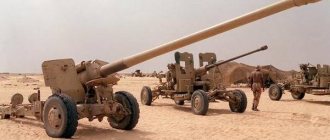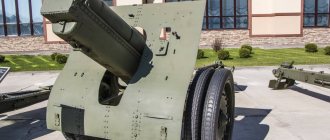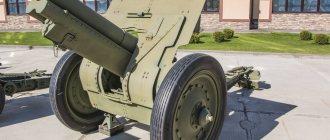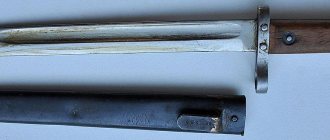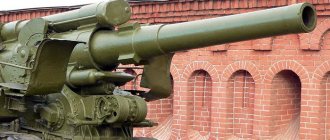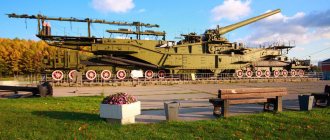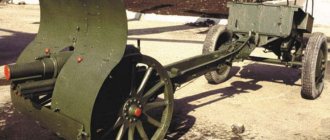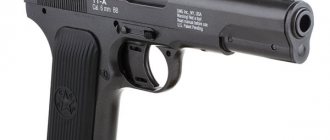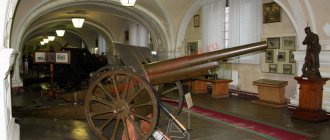The history of the creation of the 152-mm howitzer gun D-20
The Soviet 152 mm D-20 gun-howitzer was created together with the 122 mm D-74 gun as a “hull duplex”.
“Duplex” of two specialized, and at the same time assembled for the most part from the same blocks of artillery systems, made it possible, firstly, to solve the full range of tasks facing corps artillery, and secondly, it allowed to reduce costs and simplify repairs and operation, improve the supply of spare parts and training of artillery crews. Both the 122-mm D-74 gun and the 152-mm D-20 gun-howitzer were designed immediately after the end of World War II at OKB-9 under the leadership of F. F. Petrov. The first prototype of the 122-mm D-74 cannon was manufactured by Plant No. 9 at the beginning of 1950, and on February 23, 1950 it was first tested by firing at the factory range.
With the D-20 it turned out more difficult - a monoblock 152-mm howitzer, originally called D-72, was ready in the same 1950. Only a slightly modified D-74 carriage was used as a carriage for it. But 2 years later (1952), the D-72 howitzer was reclassified into the D-20 howitzer gun (D is the factory index, and the number 20 is similar to the 152-mm ML-20 howitzer gun model 1937).
By 1953, 2 “hull duplex” batteries were manufactured, which began testing, which lasted until 1955. After completion of the tests, mass production of both guns was launched at , however, due to production delays, in fact, the first mass-produced D-74 and D-20 began to be mass-produced only in 1956.
Diagram of the 152-mm howitzer gun D-20
The D-20 became one of the first Soviet artillery systems capable of firing tactical nuclear and chemical ammunition, as well as the first 152 mm gun system with a semi-automatic wedge breech with vertical movement of the wedge. In the D-22 (2A33) modification, the D-20 howitzer gun is used as the main weapon of the 2S3 Akatsiya self-propelled gun.
In addition to the USSR/Russia, the howitzer gun was or is in service with three dozen countries, including: Azerbaijan, Afghanistan, Angola, Armenia, Belarus, Bulgaria, Hungary, Vietnam, Iraq, Iran, Yemen, Kazakhstan, China, North Korea, Congo, Moldova, Myanmar, Nicaragua, Poland, Romania, Serbia, Syria, Turkmenistan, Ukraine, Croatia, Sri Lanka, Finland, Yugoslavia. As of 2015, the D-20 howitzer guns of the Russian Army were put into reserve and withdrawn from service.
Soviet 152 mm gun-howitzer D-20
Production history [edit]
Production of the M-10 began at plant No. 172
in 1939. Four were produced by the end of the year, with another 685 in 1940 and 833 in 1941. [1] There were also about 340 barrels for the KV-2 heavy tanks. built (334 production tanks and several experimental and development vehicles). [2]
Soon after the start of the war, mass production of the pistol was stopped. Commonly cited reasons are: [3]
- The M-10 was considered too heavy for divisional artillery and not powerful enough for corps artillery;
- Problems with the production process;
- There is no need for this type of weapon in the defensive phase of the war.
Some found these arguments dubious. Later in the war, corps artillery used the 152 mm M1943 (D-1) howitzer with the same ballistics. The pace of production increased. Even at the beginning of the war, the Red Army was not passive, but tried to attack at every opportunity; In addition, howitzers are certainly useful in defensive combat, for example, for suppressing enemy howitzers. Historian M. Svirin instead offered the following explanation:
- Lack of powerful artillery tractors;
- Problems with maintenance and repair;
- The complexity and steel tension of transportation;
- Soviet artillery factories were either lost or were busy producing other equipment that had a higher priority.
D-1 abroad
The D-1 howitzer was sold or transferred to a large number of countries around the world. It is still in service with the armies of some CIS countries, as well as the armed forces of China, Afghanistan, Iraq, Hungary, Mozambique, Syria, Vietnam, Cuba, Albania and a number of other states. The distribution of this howitzer was even more widespread in the recent past, when it was in service with member states of the Warsaw Pact, for example, Poland. The weapon was used in combat in the Arab-Israeli wars, as well as in conflicts on the territory of the former USSR [ source not specified 561 days
].
Combat use
The first serious conflict in which the Acacia self-propelled gun took part was the war in Afghanistan. In the 40th Army, 2S3 was the most common artillery mount. These self-propelled howitzers usually provided direct support to assault units. To protect against heavy-caliber DShK machine guns, the hull and turret of the self-propelled gun were hung with tracks or boxes of sand. Since 1984, 2S3 began to be used to escort convoys, which were often fired upon by the Mujahideen.
The Akatsiya self-propelled gun participated in almost all conflicts that arose on the territory of the USSR after its collapse. These units were used during the Transnistrian conflict, the Georgians used the Acacia during the war in Abkhazia, and this self-propelled unit was used by Russian troops in the first and second Chechen campaigns.
In 2008, Russian and Georgian troops used Akatsiya in Ossetia.
Currently, the 2S3 self-propelled gun is used by both warring parties in eastern Ukraine.
Currently, these self-propelled guns are actively used by the Syrian government army against the rebels.
Despite its very advanced age, “Acacia” continues to regularly perform military service not only in our country, but also abroad. The military loves this self-propelled gun for its simplicity and reliability. Most likely, she will remain in combat formation for a long time. As the experience of recent military conflicts shows, artillery will remain the “god of war” for a long time, and it is unlikely that it will be possible to find an equivalent replacement for it.
Interesting facts about D-1
- Like other 152 mm guns, the work of the loader and carrier in the crew was very difficult - it was necessary to carry shells weighing over 40 kg alone.
- The 53-OF-530 shells, which were developed in the late 1930s and used by the D-1 howitzer, are suitable for firing from more modern howitzers in service with the Russian Army.
- The method of manufacturing concrete-piercing shells for the D-1 howitzer influenced their combat characteristics: the 53-G-530Sh shell could be fired at full (the most powerful) charge, but the 53-G-530 shell was strictly prohibited, in order to avoid its rupture in the barrel guns. The maximum charge allowed for the 53-G-530 was the first one; accordingly, its initial speed and depth of penetration into the concrete were less than those of the 53-G-530Sh.
- Unlike many other types of guns, the Finnish army, apparently, did not manage to capture a single serviceable D-1 howitzer - there is no D-1 howitzer in the rich exhibition of the Finnish artillery museum in Hämeenlinna.
Gun 2A36 "Gyacinth-B" - video
https://youtube.com/watch?v=sJi0tkq2sok
Unlike previous Soviet-designed artillery systems, the 2A36 is a completely new design. The 49-caliber barrel is equipped with a multi-slit muzzle brake; double-frame carriage with pallet; the wheel travel is biaxial. In the combat position, the wheels are suspended using a hydraulic jack. Unusual for Soviet artillery systems is the hydraulically driven loader, which operates in combination with an automatic bolt with horizontal stroke. Such a system allows the 2A36 cannon to fire up to six rounds per minute; Thus, one battery of eight 2A36 guns is capable of raining down almost a ton of shells on a target in one minute. Like most Soviet guns, the 2A36 is equipped with a shield to protect the gun's various systems; in addition, there is a small shield above the recoil shock absorber.
The long barrel of the 2A36 cannon imparts a high initial velocity to the projectile, equal to approximately 800 m/s, which allows for a correspondingly long shot range of 27,000 meters when using standard ammunition. There is a report that when using an active-missile projectile, a firing range of 40,000 meters has been achieved. The 2A36 cannon fires cannon-loading ammunition with extended projectiles - this type of ammunition is used only by the 2S5 self-propelled gun; At one time, these included tactical nuclear shells. Other types include high-explosive fragmentation projectile (the most common, weighing 46 kg), concrete-piercing, incendiary and chemical (currently withdrawn from service). When firing directly at armored targets, an armor-piercing projectile is used.
Howitzer D-1 – video
https://youtube.com/watch?v=nbsqfByhLY8
The double-frame carriage, shield and recoil mechanism of the 122 mm M-30 howitzer were combined with the barrel of the 152 mm M-10 howitzer (model 1938), which made it possible to use the M-10 family of ammunition with variable propellant power. Where necessary, the M-30's chassis was reinforced to withstand the additional load.
The result was a howitzer of a very successful design, almost 1000 kg lighter than the excessively heavy 152-mm M-10 howitzer, which the D-1 replaced at several artillery factories. The lighter D-1 is easier to handle, but it retains the same maximum firing range (12,400 meters) and penetration power as its prototype. Moreover, the D-1 turned out to be so successful that it is still in service with the armies of the CIS countries and former members of the Warsaw Pact, although it is mainly used for training purposes and is in reserve, and is also widely used in other countries, in including in China (which produces an almost completely identical modification of the 152 mm Type 54). Iraq, Cuba and Egypt (among others).
The main type of D-1 ammunition used is a highly effective 40 kg high-explosive fragmentation shell containing almost 6 kg of TNT, although other types of ammunition have been developed over the years, including smoke grenades and chemical shells filled with lewisite (now are not used). Other types of ammunition include special concrete-piercing ones, used for the destruction of defensive structures and during combat operations in urban settlements, as well as anti-tank cumulative, currently withdrawn from service everywhere except Romania, where a cumulative projectile with a stabilizing agent is still produced plumage of our own design.
Combat use
D-1 howitzers were actively used at the final stage of the war, in 1944-1945. The gun was used for firing from closed positions at the enemy's dug-in and openly located manpower, his fortifications and obstacles, for counter-battery combat and the destruction of important objects in the enemy's near rear. To destroy enemy tanks and self-propelled guns in self-defense, a concrete-piercing projectile was successfully used. Among artillerymen, the D-1 gained a reputation as a reliable and accurate weapon when firing.
Project evaluation
The D-1 howitzer, at a minimum, was not inferior in its characteristics to the best world models of guns of this class. It fully satisfied the requirements of the Red Army in terms of mobility, power and firing range. The wide distribution of the D-1 throughout the countries of the world and its long service in their national armies serve as sufficient confirmation of this.
For comparison, the most popular German 15 cm heavy field howitzer sFH18 had a maximum firing range of 13,325 m, surpassing the D-1 by almost a kilometer; but at the same time it was almost 2 tons heavier (travel weight 5510 kg), which greatly limited mobility. The Germans failed to put the more advanced sFH36 howitzer, which has excellent characteristics (firing range 12,500 m, weight in the stowed position 3,500 kg), into large-scale production. The Czech 150-mm howitzer Škoda K4 (German name sFH37(t)) had a firing range of 15,750 m and a mass of 5,730 kg, significantly superior to the D-1 in terms of firing range, but at the same time greatly inferior in mobility (this weapon is closer to powerful howitzers - guns). The same can be said about the Italian 150-mm howitzer model 1937 (Italian: Obice da 149/19 modello 37) (14,250 m, 5,500 kg) and the American 155-mm howitzer M114 (14,600 m, 5,800 kg). French 155-mm howitzers Schneider mod. 1917 (French Canon de 155 C modèle 1917 Schneider) were inferior to the D-1 both in firing range (11,200 m) and in weight (4300 kg), and by the beginning of World War II they were clearly outdated, like the British 6- Vickers inch howitzers (BL 6-inch 26 cwt howitzer), created in 1915.
Organization and employment [edit]
M-10 howitzer on display at the Helsinki War Museum.
An M-10 howitzer at the US Army Artillery Museum.
According to the organization of 1939, each rifle division had a howitzer regiment with a 152-mm howitzer battalion (12 pieces). In July 1941, these regiments were decommissioned. The same fate befell the 152-mm howitzer divisions of the motorized and armored divisions.
In 1944, the Red Army rifle corps each had one artillery regiment. This regiment consisted of five batteries (20 in total), equipped with 152 mm howitzers, 122 mm or 107 mm guns.
The reserve of the High Command included howitzer regiments (48 units) and heavy howitzer brigades (32 units). They could be organized into artillery divisions. [1]
On June 1, 1941, there were more than a thousand M-10s in the Red Army. [4] Many were lost early in the war, coupled with the decision to halt production, meaning that only a limited number remained in service; these remaining guns were used in declining numbers until the end of World War II. The M-10 was used against personnel, fortifications and key objects in the rear.
Many guns were captured by the Wehrmacht at the beginning of the war and adopted as the 15.2 cm sFH 443(r)
.
The Finnish Army captured 45 and an additional 57 were acquired from Germany in 1944. In Finland, the howitzer, designated 152 H 38
, was issued to five heavy artillery battalions and saw active use in combat. The Finns liked the pistol, but found it a little heavy. After the end of hostilities, the M-10 remained in Finnish service; in the 1980s there were some considerations for modernizing it, but this idea was abandoned; the weapon was stored in army warehouses until 2000, when it was finally decommissioned and scrapped.
Surviving M-10 howitzers can be seen in various military museums and war memorials, such as:
- Museum of Artillery and Engineering Troops, St. Petersburg, Russia,
- Brest Fortress ,
- US Army Ordnance Museum,
- Helsinki War Museum
- Finnish Artillery Museum Hämeenlinna,
- National War Museum, Romania, Bucharest,
- Military Museum, Dej, Romania.
- Crisbecq Battery Museum, Saint-Marcouf-de-l'Isle, France.
Notes
- In the 30s The government of the USSR introduced letter indices to designate mechanical engineering production. The index “D” was assigned to the Ural Heavy Engineering Plant (Uralmashzavod), so the products created at this enterprise had the index “D” in their names - D-10, D-30, etc.
- ↑ Shirokorad A. B.
Encyclopedia of domestic artillery. - Mn.: Harvest, 2000. - 1156 p. - ↑ Shunkov V.N.
Weapons of the Red Army. - Mn.: Harvest, 1999. - 544 p. - ↑ Firing tables for 152-mm howitzers mod. 1943 - M.: Military Publishing House of the Ministry of Defense, 1968.
- Kolomiets M. V.
KV. "Klim Voroshilov" - breakthrough tank. - M.: Yauza, Eksmo, 2006. - 136 p. - Zheltov I. G., Pavlov I. V., Pavlov M. V., Solyankin A. G.
Soviet medium self-propelled artillery installations 1941-1945. - M.: Eksprint, 2005. - 48 p. - , With. 612.
- , With. 20.
- , With. 345-347.
- , With. 78.
- , With. 81.
- , With. 678-679.
- Table of range corrections for firing the F-521 high-explosive mortar grenade from a 152-mm howitzer mod. 1909/30 - M.: Military Publishing House of the Ministry of Armed Forces of the USSR, 1946. - 3 p.
- Encyclopedia of the XXI century. Weapons and technologies of Russia. Part 18. Chemical munitions. Group 13. Class 1320. Ammunition and artillery rounds over 125 mm caliber. 152 mm chemical artillery shell. - M.: Publishing house "Weapons and Technologies", 2006. - T. Volume 12. - P. 447. - 848 p. — ISBN 5-93799-023-4.
- Timofeev M.
. Newspaper "Independent Military Review". Retrieved June 30, 2013. - Fedorov L.A.
Chapter 8. Decline of chemical warfare. Types of chemical ammunition that the Soviet Army had by 1987 // Chemical weapons - war with one’s own people (tragic Russian experience) in three volumes. - M.: Forest Country, 2009. - T. 1. The long path to chemical warfare. - pp. 307-310. — 848 p. — ISBN 978-5-91505-013-5. - Shirokorad A. B.
152-mm howitzer shells, which were in service in 1930-1960. // Encyclopedia of domestic artillery / Under the general. ed. A.E. Taras. - Mn.: Harvest, 2000. - P. 661. - 1156 p. — ISBN 985-433-703-0. - Ammunition // 152 mm howitzer mod. 1943 Service Manual / Ed. V. A. Tsybysheva. — Fourth edition. - M.: Military Publishing House of the USSR Ministry of Defense, 1971. - P. 226-272. — 376 p.
- Firing tables for 152 mm howitzer mod. 1938 and 152-mm howitzers mod. 1943 (D-1) TS/GAU No. 155 / Ed. V. V. Kuznetsova. — Third edition. - M.: Military publishing house of the People's Commissariat of Defense of the USSR, 1944. - 96 p.
- Firing tables for 152 mm howitzer mod. 1943 TS/GRAU No. 155 / Ed. G. F. Sokolova. — Sixth edition. - M.: Military Publishing House of the USSR Ministry of Defense, 1968. - 116 p.
- Shirokorad A. B.
Self-propelled guns // Equipment and weapons: yesterday, today, tomorrow. - M.: Tekhinform, 1996. - No. 6. - P. 10. - Leshchinsky Yu. M., Telegin N. N. and others.
Directory of artillery ammunition subject to disposal and destruction / Under the general editorship of Kallistov A. A. - “Nova”. — ISBN 5-87265-001-9. - Sapun Mountain. Guide/Museum of the Heroic Defense and Liberation of Sevastopol. - Simferopol: PolyPRESS, 2006. - 160 p.
- Gaming magazine LKI, October 2009, pp. 36-37.
- The Military Balance 2022. - P. 199.
- The Military Balance 2022. - P. 208.
- The Military Balance 2022. - P. 280.
- The Military Balance 2016. - P. 242.
- The Military Balance 2022. - P. 449.
- The Military Balance 2022. - P. 525.
- The Military Balance 2022. - P. 530.
- The Military Balance 2022. - P. 226.
- The Military Balance 2007. - P. 312.
- The Military Balance 2007. - P. 159.
- The Military Balance 2007. - P. 358.
- The Military Balance 2022. - P. 211.
Footnotes
- At maximum charge.
- Equipped with a persistent type of toxic substance.
- Toxic substance R-43 (viscous lewisite).
- Equipped with an unstable type of toxic substance.
- Poisonous substance R-55 (soman).
- Toxic substance R-35 (sarin).
Notes[edit]
- ^ a b c d Shirokorad A.B. — Encyclopedia of Soviet Artillery
. - ↑
Kolomiets M.V.
— K.V.
Breakthrough tank "Klim Voroshilov" . - ^ ab Shunkov V.N. — Weapons of the Red Army
. - 1058 according to Ivanov A. - Artillery of the USSR in World War II
and https://www.soldat.ru/doc/mobilization/mob/table17.html, 1,128 according to Isaev A. -
Antisuvorov
. - ^ ab Ballistic tables for the 152 mm howitzer mod. 1943
Description of design
The structure of the D-1 howitzer: 1 - sliding frames, 2 - breech, 3 - shield cover, 4 - recoil devices (recoil and knurl), 5 - barrel, 6 - muzzle brake, 7 - wheel travel, 8 - wheel suspension. Elements 1, 7 and 8 make up the gun carriage; 2, 4, 5 and 6 - barrel group.
The D-1 howitzer was a very advanced weapon for its time. The gun barrel, almost identical to the barrel of the M-10 howitzer, was equipped with a DT-3 two-chamber muzzle brake. The main design features of the D-1 howitzer barrel group include variable recoil length, a piston-type bolt, a hydraulic recoil brake and a hydropneumatic knurler. Loading is separate cartridge case; in total, 8 different propellant charges were provided for the gun.
The gun carriage is almost identical to the M-30 howitzer carriage. The frames on the guns of the first series were riveted, then they began to be welded. Later series guns were additionally equipped with rollers for manual rolling. All D-1 howitzers were equipped with steel wheels with rubber pneumatic tires, and the wheel travel was equipped with suspension. The gun did not have a limber; transportation was carried out exclusively by mechanical traction. The permissible speed for transporting a gun on asphalt or a flat dirt road was up to 40 km/h, on cobblestones - up to 30 km/h, and off-road - up to 10 km/h. To protect the crew from bullets and small fragments, the D-1 howitzer had a shield cover.
Modifications and variants of the 152 mm D-20 gun-howitzer
- D-22 (Russia) — A gun for the 2S3 Akatsiya self-propelled gun.
- Type 66 (China) - licensed Chinese version of the D-20.
- D-20M "Khitin" (Russia) - a modernized version with an automatic rammer, increasing the rate of fire to 7-8 rounds/min. The modification is oriented for export.
- Type 83 (China) - Chinese version of the 2S3 Akatsiya self-propelled gun, with a Type 66 gun.
- A411 (Romania) - 152 mm M1981 towed gun-howitzer copying the D-20, but using its own 152 mm ammunition, which (with a barrel length of 20.5 calibers) has a maximum range of 17.2 km.
Shot from a 152 mm D-20 howitzer gun
• Artillery Directory • Artillery of the same period •
Tactical and technical characteristics of the BR-2 gun
— Caliber, mm: 152.4 — Copies: no less than 37 — Crew, people: 15 — Rate of fire, rds/min: 0.5
Firing range of the BR-2 cannon
— Maximum range, m: 25,000
BR-2 gun weight
— Weight in stowed position, kg: 13,800 (carriage carriage with limber), 11,100 (gun cart) — Weight in firing position, kg: 18,200
Overall dimensions of the BR-2 gun
— Length, mm: 11,448 (in combat position) — Width, mm: 2490 (in combat position) — Ground clearance, mm: 320 (carriage carriage), 310 (gun carriage)
BR-2 gun speed
— Carriage speed on the highway, km/h: up to 15 (separate)
— Height of the firing line, mm: 1920 — Barrel length, mm/club: 7170/47.2 — Barrel bore length, mm/club: 7000/45.9
— Angle of fire VN, degrees: from 0 to +60° — Angle of fire GN, degrees: 8°
152 mm howitzer model 1943 (D-1)
152-mm howitzer model 1943 (D-1, GAU Index - 52-G-536A) - Soviet howitzer during the Second World War. This gun was mass-produced from 1943 to 1949.
, was or is still in service with the armies of many countries around the world, and was used in almost all significant wars and armed conflicts of the mid and late 20th century.
The adoption of the mobile and powerful D-1 howitzer in 1943 increased the capabilities of tank and motorized units of the Workers 'and Peasants' Red Army (RKKA) to break through well-fortified enemy defensive zones and areas in advance.
History of creation
In 1941, for a number of reasons, serial production of 152-mm howitzers of the 1938 model (M-10) was stopped. According to the famous Russian historian M. Svirin, these included: A shortage of powerful tractors capable of effectively towing the M-10; High metal consumption and complexity in the production of the carriage; Difficulty in repairing and maintaining the weapon;
Factories No. 9 and 172 were busy with mobilization tasks for the mass production of other guns - M-30 howitzers and ML-20 howitzer guns, loss of factory No. 352; as a result, there was nowhere to produce the M-10.
One of the reasons for the cessation of production of the M-10 could also be the abolition of the corps unit in the Red Army in 1941 (most of the rifle corps were disbanded in August-September 1941) and, as a consequence, the corps artillery.
However, in the same year, rifle corps began to be formed again in the USSR and, accordingly, the corps level of the organizational structure of artillery was reintroduced. The excellent howitzer-cannon ML-20 was not suitable for corps artillery due to its large mass (i.e.
low mobility and fairly high cost), and the divisional 122-mm howitzer M-30 - due to insufficient firepower.
Therefore, at the end of 1942, the design bureau of the famous Soviet designer F. F. Petrov began to proactively design a new 152-mm howitzer, which was an overlay of the barrel group of the 152-mm howitzer mod. 1938 (M-10) on the carriage of a 122-mm howitzer mod. 1938 (M-30).
This approach made it possible to create a light but powerful howitzer using components already mastered in production, which was important in wartime conditions. https://www.youtube.com/embed/S1BxNYMVVuI
At the beginning of 1943, F. F. Petrov notified the People's Commissar of Armaments D. F. Ustinov about the new project. On April 13, 1943, D. F. Ustinov informed F. F. Petrov about the decision of the State Defense Committee (GKO) to supply 5 copies of the new howitzer by May 1, 1943 for field testing.
On May 5, two howitzers entered testing, which were completed within two days. On May 7, based on the test results, a report was signed in which the gun, after eliminating a number of minor deficiencies, was recommended for adoption.
By decree of the State Defense Committee of August 8, 1943, the gun was put into service under the official name “152-mm howitzer mod. 1943." Serial production began a month and a half later.
PRODUCTION
Production D-1, pcs. Year 1943 1944 1945 1946 1947 1948 1949 Total Manufactured, pcs. 84 258 715 1050 240 240 240 2827 Ammunition nomenclature Type GAU Index Projectile weight, kg Explosive weight, kg Initial speed, m/s Table range, m Caliber armor-piercing shells Marine semi-armor-piercing mod. 1915/28
51.07 3.2 ? ? HEAT shells HEAT 53-BP-540 27.44 ? 560 3000 Concrete-piercing shells Concrete-piercing long-range howitzer (with index Ш - filled with TNT using the auger method) 53-G-530 (53-G-530Sh) 40.0 5.1 508 (full charge) 12400 High-explosive fragmentation shells Steel long-range grenade 53- OF-530 40.0 5.47-6.86 508 (full charge) 12400 Steel cast iron long-range fragmentation grenade 53-O-530A 40.0 5.66 508 (full charge) 12400 Old grenade 53-F-533 40, 41 8.0 ? ? Old grenade 53-F-533K 40.68 7.3 ? ? Old grenade 53-F-533N 41.0 7.3 ? ? Old grenade 53-F-533U 40.8 8.8 ? ? Steel cast iron old French grenade 53-F-534F 41.1 3.9 ? ? Grenade from a 152 mm mortar mod. 1931 53-F-521 41.7 7.7 ? ? Steel English grenade for the 152-mm Vickers howitzer 53-F-531 44.91 5.7 ? ? Shrapnel Shrapnel with tube 45 sec. 53-Sh-501 41.16-41.83 0.5 (680-690 bullets) ? ? Shrapnel with tube T-6 53-Sh-501T 41.16 0.5 (680-690 bullets) ? ? Illumination shells Parachute illumination, burning time 40 sec. 3С1 40.2 ? ? ? Chemical shells Chemical howitzer 53-ХС-530 38.8? ? ? Chemical howitzer 53-ХН-530 39.1 ? ? ?
Chemical (adopted into service after the Great Patriotic War) 3X3? ? ? ?
History of development[edit]
By the early 1930s, the Red Army (RKKA) began searching for a replacement for the 152 mm M1909 howitzer and the 152 mm M1910 howitzer. These vehicles, developed before the First World War, had unsprung fixed support carriages and short barrels, which meant poor mobility, insufficient elevation and traverse angles, and short range. Although both units were eventually upgraded, resulting in the M1909/30 152mm howitzer and the M1910/37 152mm howitzer respectively, these were relatively minor upgrades that brought only limited improvements in some areas and did not affect others. It was clear that a completely new design was needed. However, at that time the Soviets had no experience in developing modern artillery pieces.
An initial attempt to solve this problem was made through cooperation with Germany. Constrained by the restrictions of the Treaty of Versailles, Germany was looking for ways to continue developing weapons, and joint projects gave them that opportunity. Among other weapons supplied by the Germans was a heavy howitzer, designated in the USSR the 152-mm howitzer M1931 (NG). Soon the production of this gun was entrusted to the Motovilikha Mechanical Plant (MMZ)
. However, only eight examples were made between 1932 and 1934 until production was stopped. The design proved too complex for Soviet industry in the early 1930s, as did other designs such as the 122 mm M1934 howitzer or the 20 mm and 37 mm autocannons. It was also considered somewhat heavy - 5445 kg in traveling configuration. But these early failures gave Soviet developers valuable experience.
M-10 at the Hämeenlinna Artillery Museum, Finland.
In 1937 F.F. Petrov and his design team at the Motovilikha Artillery Plant
started work on a new design - M-10.
Technical documentation was submitted to the Ordnance Department on 1 August 1937, and the first prototype was completed on 2 November. Ground tests (October 19-25, 1938) showed two parts: No. 302 (L/25 barrel with constant rifling) and No. 303 (L/20 barrel with progressive rifling). No. 303 turned out to be better. The tests also revealed numerous defects in the gun's design: the howitzer suffered from insufficient strength of the upper carriage, leaky recoil buffer, unreliable suspension, etc. An improved design with a longer barrel was presented for army testing in early 1939. Another series of army tests followed from December 22, 1939 to January 10, 1940, but even before it began - on September 29, 1939 - the gun was accepted into service as a 152-mm divisional howitzer of the 1938 model
.
Later, the word “ divisional”
. [1]
In service
- Armenia Armenia - 2 D-1, as of 2022
- Kyrgyzstan Kyrgyzstan - 16 D-1, as of 2022
- PRC PRC - a certain number of Type-54 (D-1), as of 2017. in service there is a significant number (2106 units together with D-20) of Type-54 guns (copy of D-1), as of 2016
- Cuba Cuba - some D-1, as of 2017
- Mozambique Mozambique - 12 D-1, as of 2022
- Rwanda Rwanda - 29 Type-54 (D-1) in disrepair, as of 2017
- Turkmenistan Turkmenistan - 17 D-1, as of 2022
Former operators
- USSR USSR
- Afghanistan Afghanistan - some, as of 2007
- Belarus Belarus - 6 D-1, as of 2007
- DPRK DPRK - a certain number, as of 2007
- Russia Russia - 700 D-1 in storage, as of 2017
203-mm self-propelled artillery mount 2S7 "Pion"
On May 1, 1957, at the parade in Moscow, heavy self-propelled guns were shown: a 406-mm artillery gun 2AZ “Kondensator-2P” (64 tons) and a 420-mm mortar 2B1 “Oka” (55 tons). Both products were extremely bulky (length - 20 meters, width - about 3 meters, height - about 6 meters) and heavy, but the weight and dimensions of the installations were actually set by nuclear scientists, who believed that the diameter of a tactical atomic projectile should be at least 400 mm. They produced only 4 copies, but the main thing is that the industry gained experience in creating artillery systems capable of firing nuclear tactical ammunition over long distances. By 1960, their development was stopped, giving preference to solving the problem of delivering a nuclear charge using tactical missile systems (For example:). Meanwhile, tactical missiles did not yet have homing systems, so their accuracy at maximum range was unsatisfactory.
It must be said that several years before this May Day parade, on May 25, 1953, the United States had already tested a system of a similar purpose at a nuclear test site in Nevada, consisting of a towed 280-mm T131 cannon (after the adoption of the M65, nicknamed “Atomic Annie” by the troops ” and a 280-mm Atomic Mk.9 (T124) Shell artillery projectile with a W9 nuclear warhead with a yield of 15-20 kT. The projectile was launched from the M65 cannon (weighing 77 tons) at a specified 32 km and successfully detonated. As with the Soviet 2A3 cannon, the American gun was bulky and unsuitable for combat. Only 20 guns were produced, which did not serve long in Western Europe. But already in 1963, the United States adopted a 155-mm projectile for self-propelled howitzers M114, M109, etc. The projectile was equipped with a W48 nuclear charge with a capacity of 72 tons of TNT (Mod 1 modification) and had outstanding weight and dimensions characteristics: length 33.3 inches, weight 128 pounds (51.2 kg). A year later, in 1964, a projectile with a W33 nuclear charge with a power of 10 kt, a length of 4.5 calibers and a weight of 110 kg was adopted for the 203-mm M110 self-propelled howitzer.
In 1964, N.S. Khrushchev resigned from the post of General Secretary of the CPSU Central Committee with his manic passion for solving all issues with the help of rocket technology. At the same time, technological readiness was achieved in the USSR: scientists achieved a reduction in the critical diameter of atomic weapons. Frankly speaking, the work that was frozen under Khrushchev only suggested the evolution of self-propelled guns that were put into service during the Great Patriotic War (for example, ISU-152 to ISU-152K, etc.). By this time, it became obvious that the USSR was significantly lagging behind the United States in self-propelled artillery and in the creation of small-caliber nuclear charges for conventional guns, i.e. in providing army units with tactical atomic weapons. To eliminate this backlog, development work began in December 1967 to create a heavy self-propelled artillery mount. Initially, neither the type of gun nor even its caliber was specified. Only the firing range was determined - 25 km. As a result, a decision was made to develop an open self-propelled gun with a high-power cannon (firing range with a conventional projectile is 32 km, and with an active-missile projectile - 45 km). On July 8, 1970, Resolution of the Central Committee of the CPSU and the Council of Ministers of the USSR No. 427/161 was issued, which began the development of a self-propelled gun, designated 2S7 and named “Pion.” The Leningrad Kirov plant was appointed the main developer and executor; the swinging part was manufactured by the Volgograd plant “Barricades” according to the design of the Central Design Bureau “Titan”.
